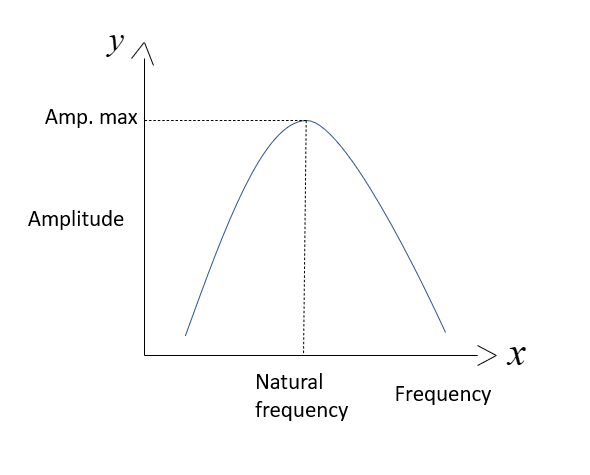
In the resonance curve, the natural frequency is where the _________ of the curve occurs,
A) Peak
B) Cusp
C) Foot
D) Any point
Answer
565.8k+ views
Hint: Natural frequency is the frequency attained when the amplitude of the wave reaches its maximum value. Eigen frequency is known as the natural frequency. And the resonance curve occurs when the amplitude of the curve reaches maximum. This increased amplitude happens when the frequency applied is equal to the natural frequency.
Complete step by step answer:
(i) The resonance curve is the curve whose amplitude reaches its maximum value. This increased amplitude is attained by the curve when the frequency applied is equal to the natural frequency.
(ii) So, we can say that the natural frequency at the abscissa attains when it meets maximum amplitude at the ordinate. We can say the point where the amplitude is maximum is “peak”.

Hence the correct answer is option A.
Additional information:
(i) The ‘cusp’ is the point in the curve at where the curve takes two opposite directions. Thus, the cusp is called a singular point in the curve. It is usually a ‘zero’.
(ii) A curve is a one-dimensional image that has only length not having a width, breadth, etc. The curves need not be straight. It has many shapes and many types. A cusp is one form of the curve and also the loop too.
Note:
The resonance curve is due to the curve attaining the natural frequency. The natural frequency can cause irreparable damage to the devices. The natural frequency causes the curve to attain the maximum amplitude. The amplitude is the maximum distance traveled by the curve. This is also the measure equal to one-half of the distance traveled by the curve.
Complete step by step answer:
(i) The resonance curve is the curve whose amplitude reaches its maximum value. This increased amplitude is attained by the curve when the frequency applied is equal to the natural frequency.
(ii) So, we can say that the natural frequency at the abscissa attains when it meets maximum amplitude at the ordinate. We can say the point where the amplitude is maximum is “peak”.

Hence the correct answer is option A.
Additional information:
(i) The ‘cusp’ is the point in the curve at where the curve takes two opposite directions. Thus, the cusp is called a singular point in the curve. It is usually a ‘zero’.
(ii) A curve is a one-dimensional image that has only length not having a width, breadth, etc. The curves need not be straight. It has many shapes and many types. A cusp is one form of the curve and also the loop too.
Note:
The resonance curve is due to the curve attaining the natural frequency. The natural frequency can cause irreparable damage to the devices. The natural frequency causes the curve to attain the maximum amplitude. The amplitude is the maximum distance traveled by the curve. This is also the measure equal to one-half of the distance traveled by the curve.
Recently Updated Pages
Master Class 12 Chemistry: Engaging Questions & Answers for Success

A man running at a speed 5 ms is viewed in the side class 12 physics CBSE

The number of solutions in x in 02pi for which sqrt class 12 maths CBSE

State and explain Hardy Weinbergs Principle class 12 biology CBSE

Write any two methods of preparation of phenol Give class 12 chemistry CBSE

Which of the following statements is wrong a Amnion class 12 biology CBSE

Trending doubts
What are the major means of transport Explain each class 12 social science CBSE

Which are the Top 10 Largest Countries of the World?

Draw a labelled sketch of the human eye class 12 physics CBSE

Explain sex determination in humans with line diag class 12 biology CBSE

Explain sex determination in humans with the help of class 12 biology CBSE

Differentiate between homogeneous and heterogeneous class 12 chemistry CBSE




